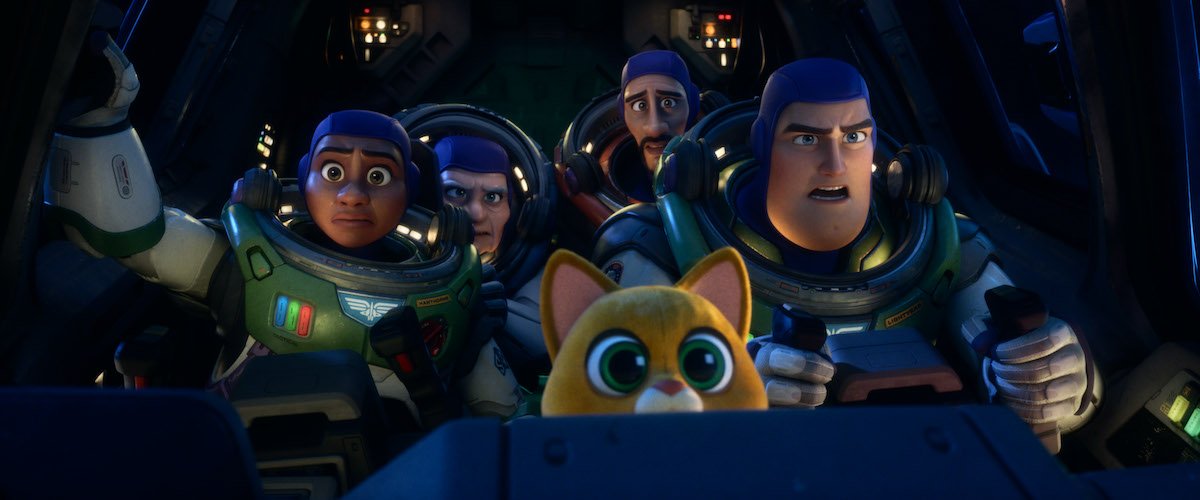ELVIS
Directing: C+
Acting: B+
Writing: C
Cinematography: B+
Editing: C-
Music: B+
The most astonishing thing about Elvis is how a movie so long (159 minutes) could still be overstuffed—and somehow leave out crucial, well-documented details of the singer’s life. It barely mentions his movie career, which included over 30 film roles between 1956 and 1969. There is a depiction of Priscilla Presley (Olivia DeJonge), but no mention of the fact that she met Elvis when she was only fourteen and he was twenty-four. That wouldn’t be convenient for the depiction of Elvis Baz Luhrmann is going for—one of objective reverence, even in light of his infidelity and drug habits.
The second most astonishing thing about Elvis is that it’s biggest liability is, of all things . . . Tom Hanks. Why this script focuses so heavily on “Colonel Tom Parker,” as depicted by Hanks, is truly a mystery. Plenty of music biopics have adopted this framework of storytelling, with a person close in the star’s orbit telling the story, but Elvis feels just as much about Parker as it does about Elvis himself. And even by Luhrmann standards, Parker’s element feels like it’s a different movie, not least of which because Hanks is put into a poorly conceived “fat suit,” given a huge fleshy chin, and apparently encouraged to go with a Dutch accent far heavier than Parker reportedly actually spoke with. Everything about Hanks’s performance in this movie is a constant distraction, and never a good one—and yet the movie spends far too much time on him at the expense of relevant details in Elvis’s own life.
Is there a third most astonishing thing about Elvis? You bet there is! This movie addresses how so much of Elvis’s music was influenced by Black music and Black culture, but does it in a blatantly revisionist way. This movie would have us believe that Elvis Presley simply grew up in a poor white family in a predominantly black neighborhood, found success using the musical styles he was surrounded by, and the Black community was delighted by his success. This is demonstrably untrue. Now, no one would ever turn to a Baz Luhrmann film for historical accuracy, but this is egregious stuff, right there in “white savior” territory.
I’ve long said that the best biopics narrow their focus, on either a particular incident or at least a single period in a person’s life. Trying to tell a person’s entire life story in the space of just one movie—even a long movie—generally renders it dull, and Elvis is no exception, its frenetic editing notwithstanding. What’s more, this style is well suited to Luhrmann’s earlier work, most notably Moulin Rouge! (2001) but also Strictly Ballroom (1992) and even Romeo + Juliet (1996), those films being the only ones regarded as “classic” in Luhrmann’s filmography, even by Luhrmann fans. (Although a fair number seemed to enjoy The Great Gatsby in 2013; I wasn’t that impressed.) There’s something about Luhrmann’s style that sets the viewer at a remove from the story, never offering a chance to connect on a deeply emotional level—something that should really be possible in the telling of Elvis Presley’s story. Luhrmann was always more interested in visual innovations than emotional resonance, and his style is so recognizable now that it could hardly even be called innovative anymore.
In other words, Elvis would have been much improved if told by another director. Instead, we get a production depicting a quintessentially American figure that was filmed in Australia, exclusively on movie lots and with recognizable American landscapes and skylines rendered in obvious CGI. Luhrmann’s earlier films were set in obvious fantasy worlds, in which this sort of artifice worked for the story at hand.
But! All that said, Elvis does have some redeeming qualities, by far the most important of which is the performance of Austin Butler, who is eminently convincing as Elvis Presley. He has a naturally passing resemblance to the man, at least when he was young (oddly, Butler is never in any obvious fat suit when depicting “older, fatter Elvis”), and his actual singing voice is used in many of the performances. Butler has a magnetic screen presence, just as Elvis had a magnetic stage presence, and both of those facts are bizarrely obscured by telltale rapid-fire editing.
Elvis is also packed with music, though, and the music is almost uniformly great—at least when it’s classic Elvis tunes, as well as Black singers performing the songs Elvis later covered (those are arguably the best tacks on the soundtrack). Elvis does sprinkle in several contemporary tracks, often with rap vocals, as if in an attempt to acknowledge the lasting influence of Black music. The rap tracks are a bit misplaced, though. Honestly, someone should make a movie “about Elvis” that focuses on the Black artists who either “inspired” him or from whom he outright stole, depending on how you (or they) look at it.
Butler’s performance and the music throughout the movie are almost enough to make Elvis worth what is clearly made to be a theatrical experience rather than something viewed at home. Almost. It might well have gone all the way if there were less “Dutch Hanks” and a lot more of Butler, singing as well as acting (his performance is excellent).
It’s also hard not to wonder if this movie kind of missed the boat, having been released about twenty years too late. There were some clear Elvis fans in the row behind me at the theater, and they were deeply invested in the story, quite openly commenting on how they felt about certain characters’ behaviors, all of them depicting as hangers-on who were bringing down an otherwise innocent Elvis Presley. Huge fans of Elvis today, who would now almost exclusively be among the elderly set, will surely enjoy this movie. But, Elvis has not been an active part of the pop culture conversation in decades, and this movie could have found a lot larger audience back when more of his own fans were still alive.
In other words, Baz Luhrmann stopped far short of the greatness his movie Elvis could have been, and is offering it too late. Clearly I am not the only one who feels this way; the film has already grossed over $55 million worldwide, although with a budget of $85 million, it will likely barely break even, if even get to that point. I don’t regret having gone to see it, and found it moderately entertaining for what turned out to be far too long a time, but this is not re-watch material. The memory of this movie will get filed away in the back of my mind, in a drawer that never needs to be pulled open again.
You can’t look away . . . whenever he’s actually onscreen.
Overall: B-








